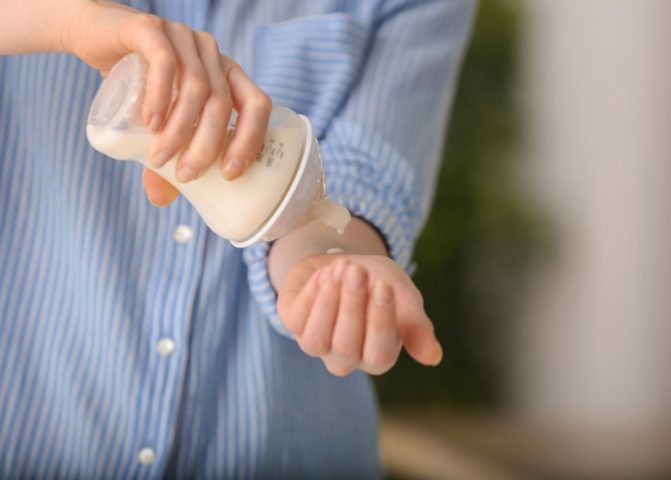Baby Formula – How Much and How Often?

Table of Contents
- What is Baby Formula?
- What Are the Different Types of Formulas?
- How is Baby Formula Different From Breast Milk?
- What Are the Reasons to Use Baby Formula?
- Can Babies Be Allergic to the Formula?
- Can I Feed My Baby Formula and Breast Milk?
- Can I Give Baby Formula After 12 Months?
- How Much Formula Milk Should Be Given to the Baby?
- Step by Step Guide to Preparing Baby Formula
Baby formula – learn about the types available, the differences from breast milk and how much to give your baby.
New mothers often have to undergo a number of challenges and make important decisions regarding their baby’s health right after giving birth – one of which is breastfeeding. Although Breastfeeding is still considered the ideal option for feeding a baby who is under six months in Australia, certain factors can prevent a mother from doing this. With the advent of increasingly improved baby formulas being produced all over Australia, the gap between natural breast milk and formula milk has been more or less bridged, and the newer formulas are now able to mimic the nutrition profile and consistency of breast milk exactly. (1)
What is Baby Formula?
Baby formula is an artificial substitute for breast milk, which you can give to your baby to fulfill their nutritional requirements. This formula is safe to be given to babies who are not affected by dietary and medical problems and is available in different forms depending on their source of origin.
What are the Different Types of Formulas?
There are three types of baby formulas mainly found in the market. These include the Cow Milk Based Baby Formula, the Soy-Based Baby Formula, and Specialized Formulas, which are mainly designed to prevent Allergies.
Cow Milk Based Baby Formula
The Cow Milk-based baby formulas, as the name suggests, are derived from natural cow milk. Cow milk contains a higher quantity of fats, proteins, and minerals as compared to human breast milk. In order to bridge the gap between the two types of milk, cow milk is required to be diluted and skimmed. The Cow milk-based baby formula contains extra added minerals, vitamins, iron, and vegetable oil for it to fulfill the complete nutritional requirements of the growing infant. (2)
Soy-Based Baby Formula
Soy-Based Baby formulas are particular suited for babies who have a congenital deficiency of lactase, which is an enzyme needed for the digestion of sugar found in natural milk known as lactose. Hence these milk formulas help infants with milk allergies. You should always consult your doctor before starting a Soy-Based Baby Formula, as some babies who are allergic to milk may also be allergic to soy. (3)
Hypo Allergic Baby Formula
The Hypoallergic Baby formulas are specially designed for those infants who are unable to tolerate or are allergic to cow and soy-based baby formulas. These baby formulas have proteins that have been broken down into smaller forms so that they are easily digested by the baby’s digestive tract.
Another alternate to this is the use of amino-acid-based baby formulas, and are suitable for those babies who have severe forms of cow milk allergy. The protein that is present in these formulas is in the form of amino acids, without the presence of any peptides – allowing them to be absorbed by the baby’s gut easily.
How is Baby Formula Different From Breast Milk?
Even though formula milk is specially designed to mimic human milk, there still are several differences between the two. While the human milk is constantly changing in its composition according to what the baby requires as he grows, the formula milk is static and consists of the same constituents and their concentrations over the course of feeding. (4)
Moreover, the levels of protein in the baby formula are generally higher than the human milk as the contents of the amino acids in the baby formula differ from the human milk; hence higher levels of proteins are required to provide the growing baby with all their nutritional requirements. (5)

What are the Reasons to use Baby Formula?
There may be a number of reasons why a new mother might go for a baby formula instead of breastfeeding their baby, which may be either limited to their personal preferences or maybe due to certain medical issues.
According to the Australian Government Department of Health, the common reason why a mother might opt for a baby formula instead of Breastfeeding include the presence of maternal obesity, diabetes, premature birth of the baby, or multiple births. Moreover, it may be due to the presence of cracked nipples of the mother or certain congenital anomalies in the baby that do not permit the baby to feed naturally from the breast. A lot of new mothers may also undergo postpartum depression and severe degrees of anxiety and altered body image, which does not allow them to breastfeed the baby, and baby formula is considered a better option.
Can Babies Be Allergic to the Formula?
Some babies can be allergic to cow or soy-based baby formulas and must be given the hypoallergic alternative, which includes the amino acid-based baby formulas and the hydrolyzed formulas. Hence, whenever your child suddenly starts showing symptoms of allergy like digestive problems and skin rashes, you must consult a doctor to find out the root cause of the allergy. If the formula milk is found to be the culprit, there is a need to switch to a hypoallergic formula according to the doctor’s recommendation.
Can I Feed My Baby Formula and Breast Milk?
Baby formula can be fed along with breast milk, and this is known as the Combination Feeding Method. This may either be given due to a lower volume of breast milk, medical reasons concerning the baby or the mother, or may just be for the personal choice and convenience of the mother.
Can I give Baby Formula After 12 Months?
According to the Australian Government Department of Health, baby formula is recommended to be used for at least 12 months of age. After this time, it may be discontinued after consultation and assessment from the doctor.
How Much Formula Milk Should Be Given To the Baby?
It is recommended by the Queensland Health that the ideal way to feed the baby is on their demand. This is because every baby is unique, and their nutritional requirement is different from each other. However, the general guideline which should be followed for the amount of baby formula which needs to be fed to the baby is stated below:
- A baby who is between 5 days to 3 months old needs to be fed 150 ml per kg weight every day.
- A baby who is between 3 to 6 months old needs to be fed 120 ml per kg body weight every day.
- A baby who is 6 to 12 months needs to be fed 100 ml per kg of body weight every day.

Step By Step Guide To Preparing Baby Formula
- Firstly, wash your hands properly with soap and water to remove germs and impurities.
- Next, Wash and sterile the baby bottle along with all its parts thoroughly.
- Boil the measured amount of fresh water, and let it sit for at least 30 minutes to cool down.
- Then pour the water into the bottle and add a measured amount of baby formula to it. You should ideally take out the baby formula from the given scoop by the manufacturer and should make sure that the scoop is leveled.
- Next, secure the bottle cover and shake it until the formula is completely dissolved.
- You should check the temperature of the milk by pouring a few drops out on your wrist before feeding it to the baby. To make sure it is not too hot.
- The formula should be ideally fed to the baby immediately after it is made. If you have to store the milk, it should be kept in a fridge and must be used within 24 hours.
References:
- Abayomi, J. (2005). Infant formula–evaluating the safety of new ingredients. Journal of Human Nutrition and Dietetics, 18(3), 226.
- Koletzko B, Baker S, Cleghorn G, Neto UF, Gopalan S, Hernell O, Hock QS, Jirapinyo P, Lonnerdal B, Pencharz P, Pzyrembel H, Ramirez-Mayans J, Shamir R, Turck D, Yamashiro Y, Zong-Yi D. Global standard for the composition of infant formula: recommendations of an ESPGHAN coordinated international expert group. J Pediatr Gastroenterol Nutr. 2005 Nov;41(5):584-99. doi: 10.1097/01.mpg.0000187817.38836.42. PMID: 16254515.
- S. National Library of Medicine Infant Formulas—Overview. [(accessed on 15 May 2015)]; Available online: https://www.nlm.nih.gov/medlineplus/ency/article/002447.htm.
- Lönnerdal B, Hernell O. An Opinion on “Staging” of Infant Formula: A Developmental Perspective on Infant Feeding. J Pediatr Gastroenterol Nutr. 2016 Jan;62(1):9-21. doi: 10.1097/MPG.0000000000000806. PMID: 25844707.
- Heine WE, Klein PD, Reeds PJ. The importance of alpha-lactalbumin in infant nutrition. J Nutr. 1991 Mar;121(3):277-83. doi: 10.1093/jn/121.3.277. PMID: 2002399.
Join the Medmate Community!
Receive free expert health advice from Australian doctors and health advisors. Join the Medmate community now - just what the doctor ordered.
Health Information I Medication Education & Tips I Patient Stories & Videos.

